Conceptual designing of a slow positron beam system using Simion simulation program
The slow positron beam system is an important device in the study of positron physics and
techniques, especially in materials research. This paper presents obtained results in studying and
applying a charged particles trajectory simulation program – Simion for building feasible design
models for the system. The built models with different designs based on reference designs of some
typical systems include a straight-shaped model, a 500 bent-shaped model and a 900 bent-shaped
model. Some positron beam trajectory calculation tests have been performed for comparison between
the models. From the tests, the 500 bent-shaped model has been proposed as a conceptual design for
building a real slow positron beam system in the future in Vietnam.
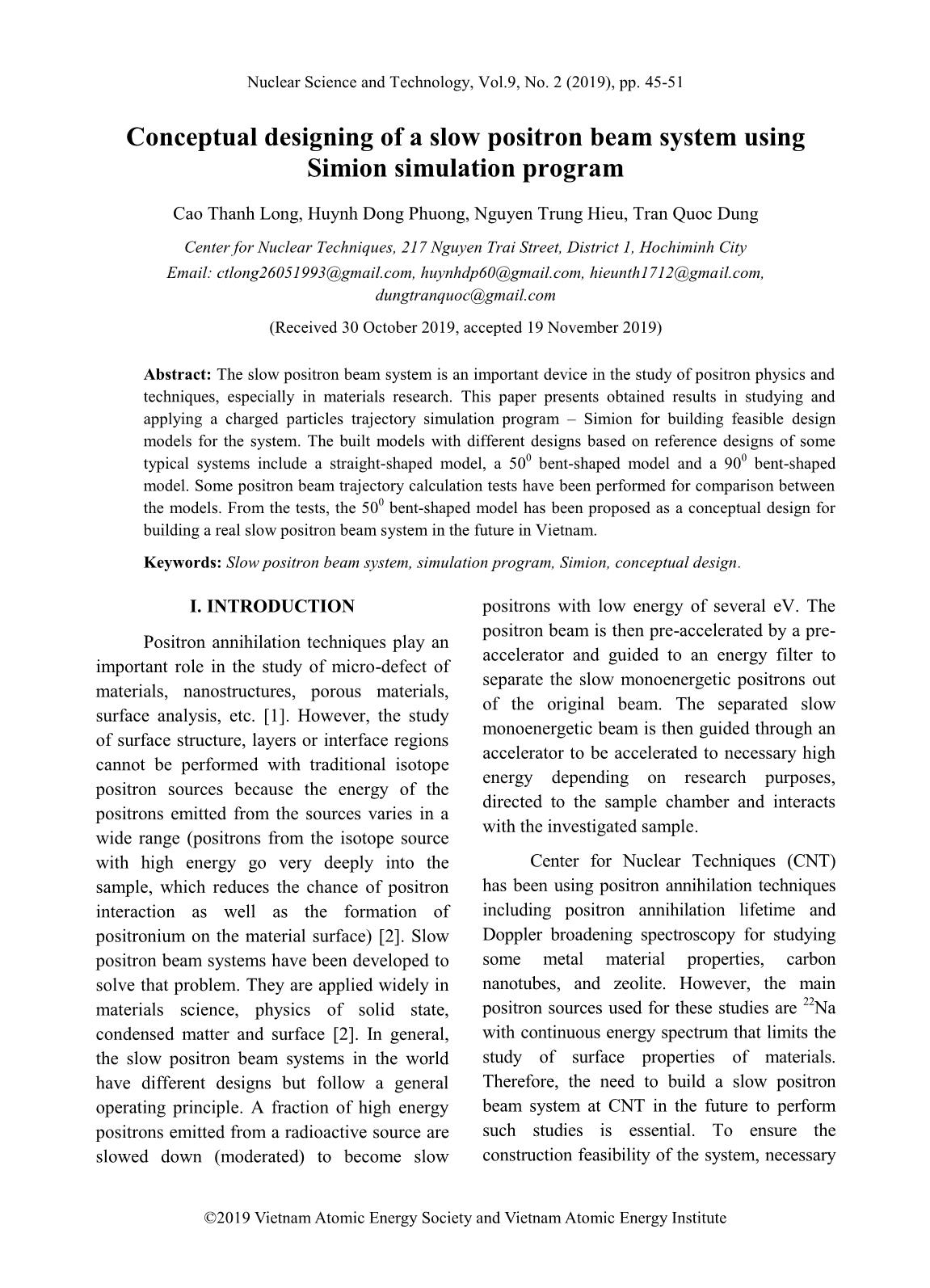
Trang 1
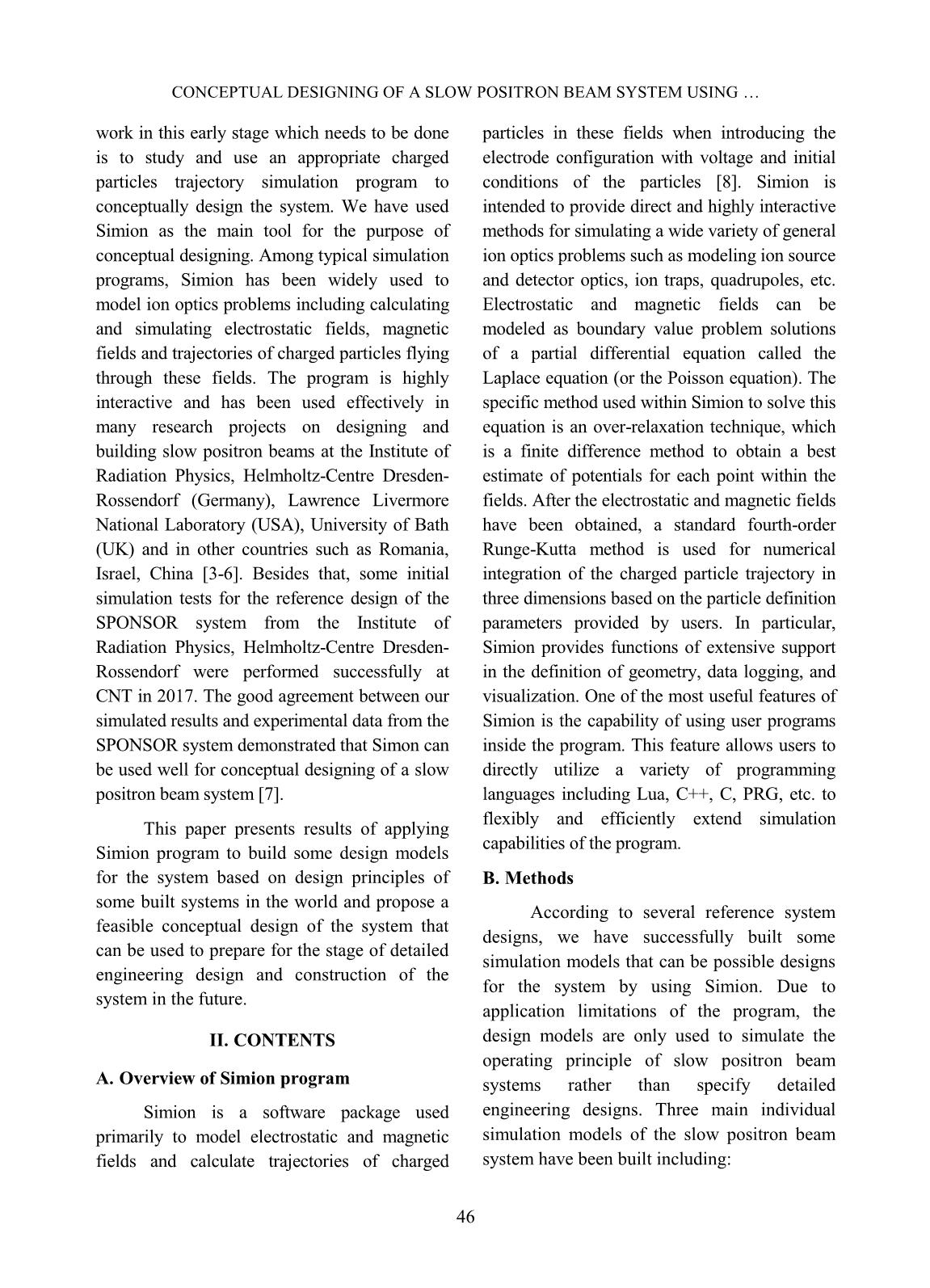
Trang 2
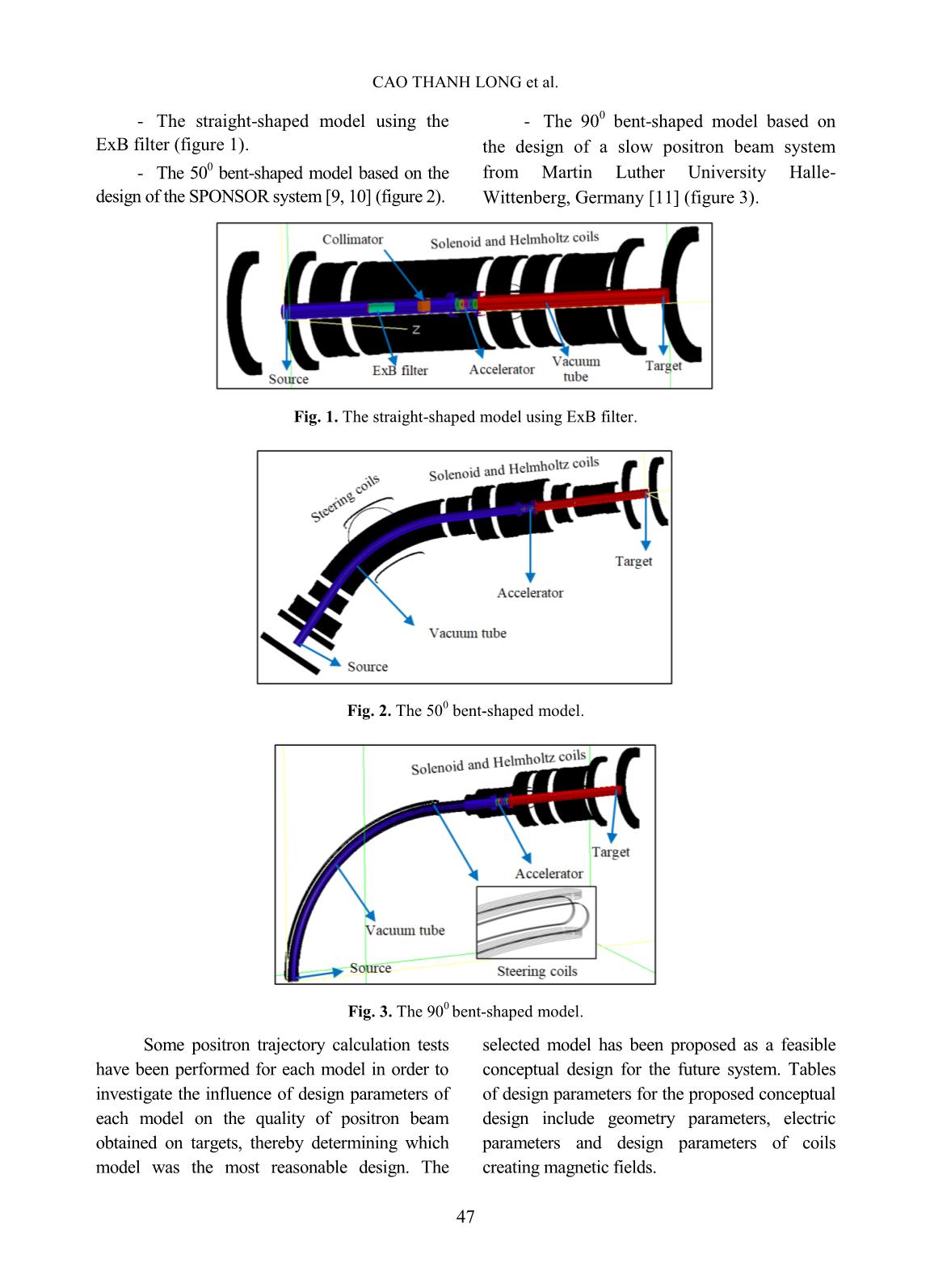
Trang 3
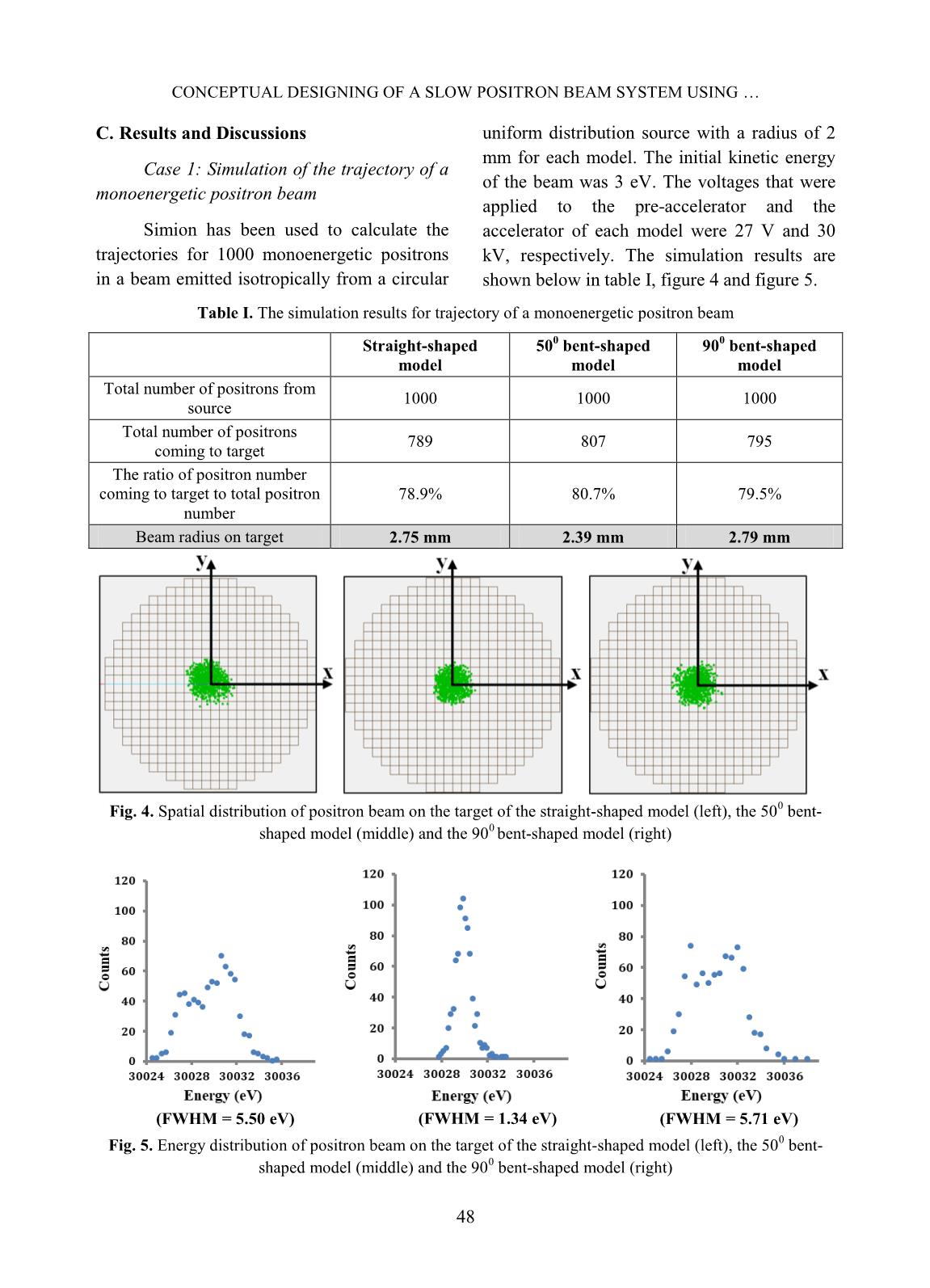
Trang 4
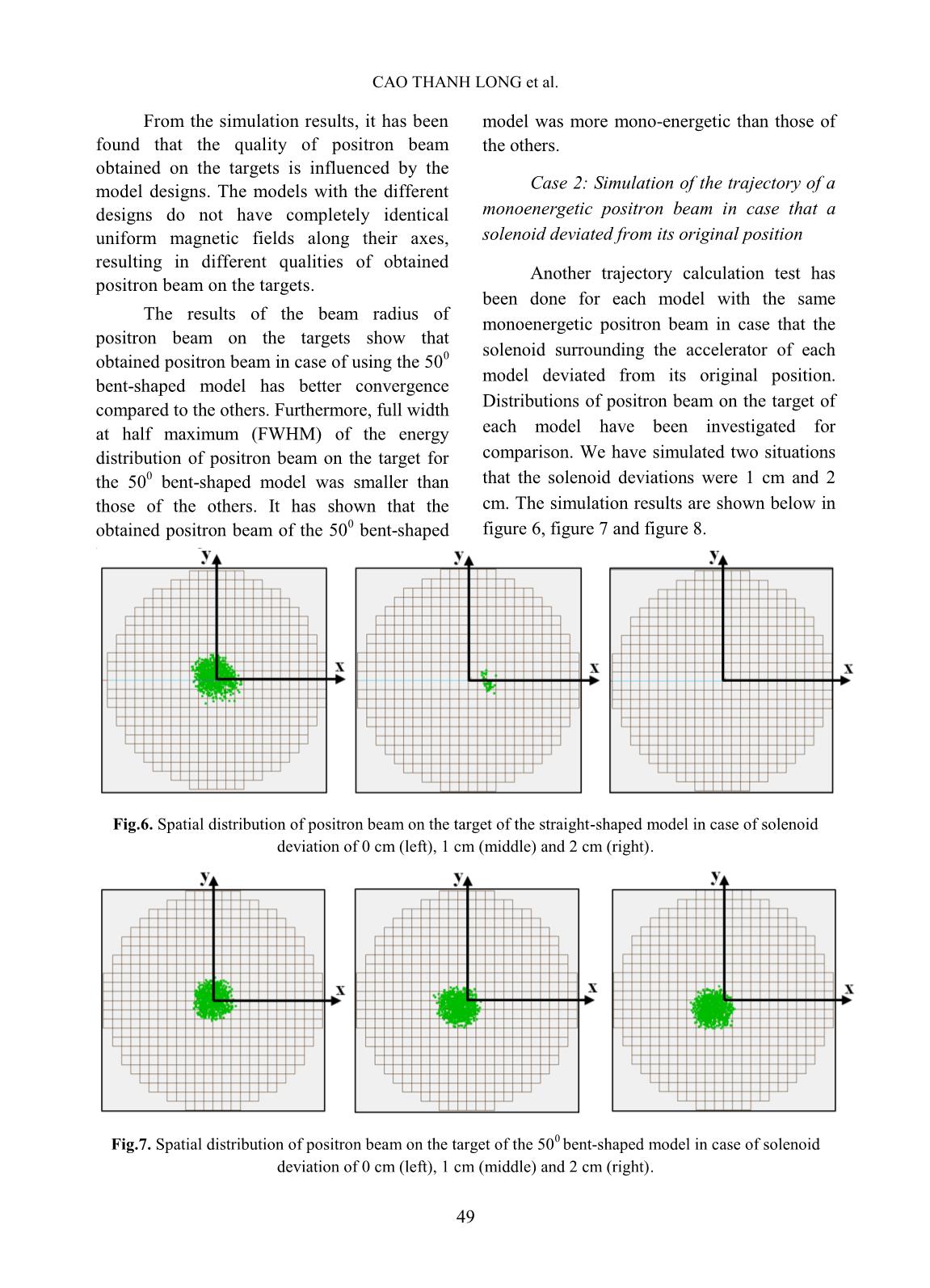
Trang 5
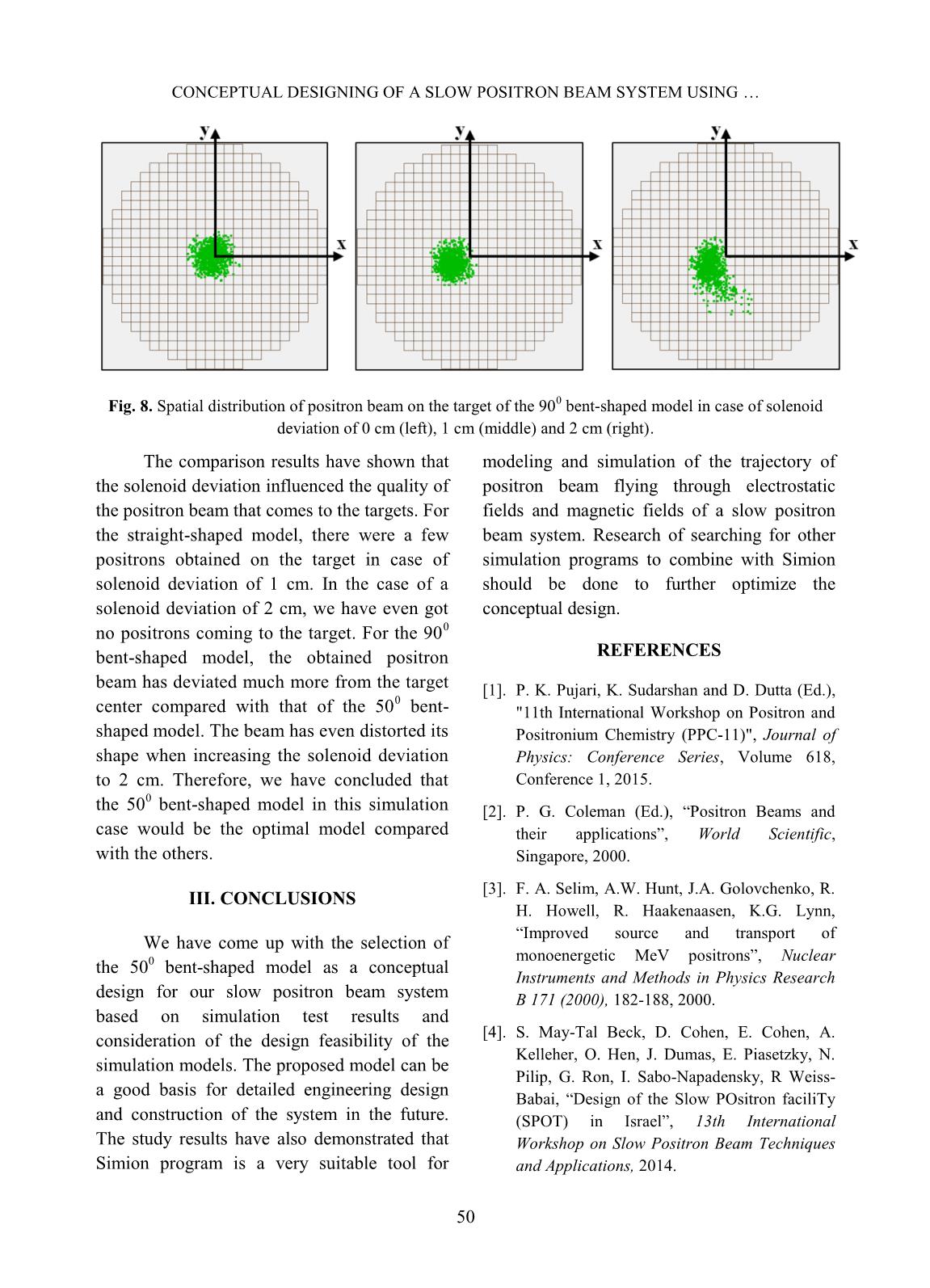
Trang 6
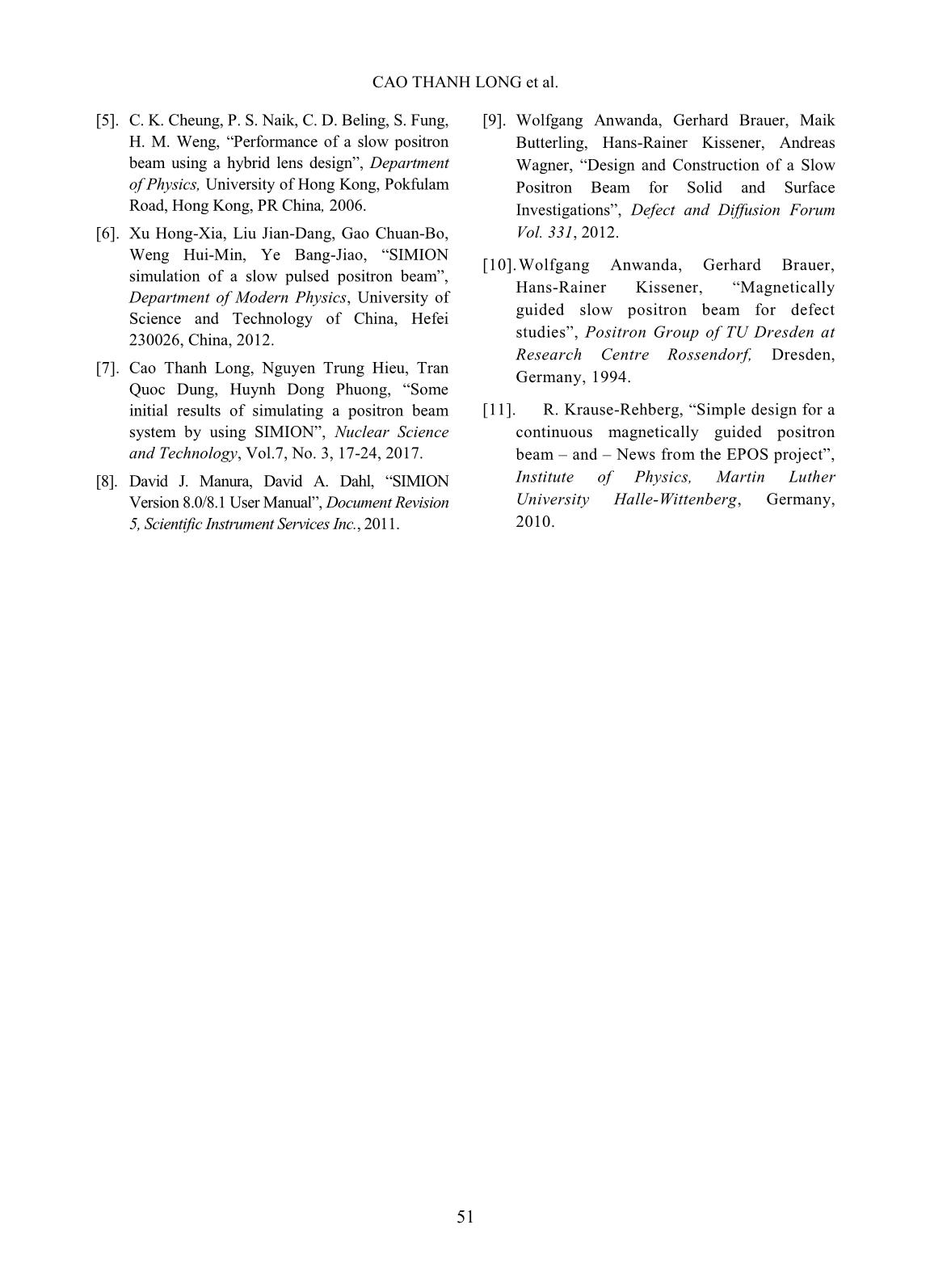
Trang 7
Tóm tắt nội dung tài liệu: Conceptual designing of a slow positron beam system using Simion simulation program
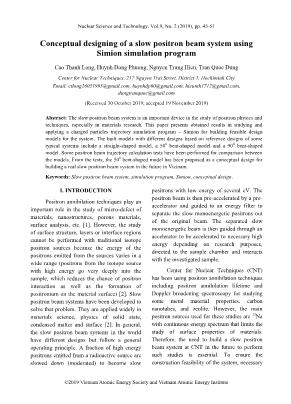
rence designs of some typical systems include a straight-shaped model, a 50 0 bent-shaped model and a 90 0 bent-shaped model. Some positron beam trajectory calculation tests have been performed for comparison between the models. From the tests, the 50 0 bent-shaped model has been proposed as a conceptual design for building a real slow positron beam system in the future in Vietnam. Keywords: Slow positron beam system, simulation program, Simion, conceptual design. I. INTRODUCTION Positron annihilation techniques play an important role in the study of micro-defect of materials, nanostructures, porous materials, surface analysis, etc. [1]. However, the study of surface structure, layers or interface regions cannot be performed with traditional isotope positron sources because the energy of the positrons emitted from the sources varies in a wide range (positrons from the isotope source with high energy go very deeply into the sample, which reduces the chance of positron interaction as well as the formation of positronium on the material surface) [2]. Slow positron beam systems have been developed to solve that problem. They are applied widely in materials science, physics of solid state, condensed matter and surface [2]. In general, the slow positron beam systems in the world have different designs but follow a general operating principle. A fraction of high energy positrons emitted from a radioactive source are slowed down (moderated) to become slow positrons with low energy of several eV. The positron beam is then pre-accelerated by a pre- accelerator and guided to an energy filter to separate the slow monoenergetic positrons out of the original beam. The separated slow monoenergetic beam is then guided through an accelerator to be accelerated to necessary high energy depending on research purposes, directed to the sample chamber and interacts with the investigated sample. Center for Nuclear Techniques (CNT) has been using positron annihilation techniques including positron annihilation lifetime and Doppler broadening spectroscopy for studying some metal material properties, carbon nanotubes, and zeolite. However, the main positron sources used for these studies are 22 Na with continuous energy spectrum that limits the study of surface properties of materials. Therefore, the need to build a slow positron beam system at CNT in the future to perform such studies is essential. To ensure the construction feasibility of the system, necessary CONCEPTUAL DESIGNING OF A SLOW POSITRON BEAM SYSTEM USING 46 work in this early stage which needs to be done is to study and use an appropriate charged particles trajectory simulation program to conceptually design the system. We have used Simion as the main tool for the purpose of conceptual designing. Among typical simulation programs, Simion has been widely used to model ion optics problems including calculating and simulating electrostatic fields, magnetic fields and trajectories of charged particles flying through these fields. The program is highly interactive and has been used effectively in many research projects on designing and building slow positron beams at the Institute of Radiation Physics, Helmholtz-Centre Dresden- Rossendorf (Germany), Lawrence Livermore National Laboratory (USA), University of Bath (UK) and in other countries such as Romania, Israel, China [3-6]. Besides that, some initial simulation tests for the reference design of the SPONSOR system from the Institute of Radiation Physics, Helmholtz-Centre Dresden- Rossendorf were performed successfully at CNT in 2017. The good agreement between our simulated results and experimental data from the SPONSOR system demonstrated that Simon can be used well for conceptual designing of a slow positron beam system [7]. This paper presents results of applying Simion program to build some design models for the system based on design principles of some built systems in the world and propose a feasible conceptual design of the system that can be used to prepare for the stage of detailed engineering design and construction of the system in the future. II. CONTENTS A. Overview of Simion program Simion is a software package used primarily to model electrostatic and magnetic fields and calculate trajectories of charged particles in these fields when introducing the electrode configuration with voltage and initial conditions of the particles [8]. Simion is intended to provide direct and highly interactive methods for simulating a wide variety of general ion optics problems such as modeling ion source and detector optics, ion traps, quadrupoles, etc. Electrostatic and magnetic fields can be modeled as boundary value problem solutions of a partial differential equation called the Laplace equation (or the Poisson equation). The specific method used within Simion to solve this equation is an over-relaxation technique, which is a finite difference method to obtain a best estimate of potentials for each point within the fields. After the electrostatic and magnetic fields have been obtained, a standard fourth-order Runge-Kutta method is used for numerical integration of the charged particle trajectory in three dimensions based on the particle definition parameters provided by users. In particular, Simion provides functions of extensive support in the definition of geometry, data logging, and visualization. One of the most useful features of Simion is the capability of using user programs inside the program. This feature allows users to directly utilize a variety of programming languages including Lua, C++, C, PRG, etc. to flexibly and efficiently extend simulation capabilities of the program. B. Methods According to several reference system designs, we have successfully built some simulation models that can be possible designs for the system by using Simion. Due to application limitations of the program, the design models are only used to simulate the operating principle of slow positron beam systems rather than specify detailed engineering designs. Three main individual simulation models of the slow positron beam system have been built including: CAO THANH LONG et al. 47 - The straight-shaped model using the ExB filter (figure 1). - The 500 bent-shaped model based on the design of the SPONSOR system [9, 10] (figure 2). - The 900 bent-shaped model based on the design of a slow positron beam system from Martin Luther University Halle- Wittenberg, Germany [11] (figure 3). Fig. 1. The straight-shaped model using ExB filter. Fig. 2. The 50 0 bent-shaped model. Fig. 3. The 90 0 bent-shaped model. Some positron trajectory calculation tests have been performed for each model in order to investigate the influence of design parameters of each model on the quality of positron beam obtained on targets, thereby determining which model was the most reasonable design. The selected model has been proposed as a feasible conceptual design for the future system. Tables of design parameters for the proposed conceptual design include geometry parameters, electric parameters and design parameters of coils creating magnetic fields. CONCEPTUAL DESIGNING OF A SLOW POSITRON BEAM SYSTEM USING 48 C. Results and Discussions Case 1: Simulation of the trajectory of a monoenergetic positron beam Simion has been used to calculate the trajectories for 1000 monoenergetic positrons in a beam emitted isotropically from a circular uniform distribution source with a radius of 2 mm for each model. The initial kinetic energy of the beam was 3 eV. The voltages that were applied to the pre-accelerator and the accelerator of each model were 27 V and 30 kV, respectively. The simulation results are shown below in table I, figure 4 and figure 5. Table I. The simulation results for trajectory of a monoenergetic positron beam Straight-shaped model 50 0 bent-shaped model 90 0 bent-shaped model Total number of positrons from source 1000 1000 1000 Total number of positrons coming to target 789 807 795 The ratio of positron number coming to target to total positron number 78.9% 80.7% 79.5% Beam radius on target 2.75 mm 2.39 mm 2.79 mm Fig. 4. Spatial distribution of positron beam on the target of the straight-shaped model (left), the 50 0 bent- shaped model (middle) and the 90 0 bent-shaped model (right) Fig. 5. Energy distribution of positron beam on the target of the straight-shaped model (left), the 50 0 bent- shaped model (middle) and the 90 0 bent-shaped model (right) (FWHM = 5.50 eV) (FWHM = 1.34 eV) (FWHM = 5.71 eV) CAO THANH LONG et al. 49 From the simulation results, it has been found that the quality of positron beam obtained on the targets is influenced by the model designs. The models with the different designs do not have completely identical uniform magnetic fields along their axes, resulting in different qualities of obtained positron beam on the targets. The results of the beam radius of positron beam on the targets show that obtained positron beam in case of using the 50 0 bent-shaped model has better convergence compared to the others. Furthermore, full width at half maximum (FWHM) of the energy distribution of positron beam on the target for the 50 0 bent-shaped model was smaller than those of the others. It has shown that the obtained positron beam of the 50 0 bent-shaped model was more mono-energetic than those of the others. Case 2: Simulation of the trajectory of a monoenergetic positron beam in case that a solenoid deviated from its original position Another trajectory calculation test has been done for each model with the same monoenergetic positron beam in case that the solenoid surrounding the accelerator of each model deviated from its original position. Distributions of positron beam on the target of each model have been investigated for comparison. We have simulated two situations that the solenoid deviations were 1 cm and 2 cm. The simulation results are shown below in figure 6, figure 7 and figure 8. Fig.6. Spatial distribution of positron beam on the target of the straight-shaped model in case of solenoid deviation of 0 cm (left), 1 cm (middle) and 2 cm (right). Fig.7. Spatial distribution of positron beam on the target of the 50 0 bent-shaped model in case of solenoid deviation of 0 cm (left), 1 cm (middle) and 2 cm (right). CONCEPTUAL DESIGNING OF A SLOW POSITRON BEAM SYSTEM USING 50 Fig. 8. Spatial distribution of positron beam on the target of the 90 0 bent-shaped model in case of solenoid deviation of 0 cm (left), 1 cm (middle) and 2 cm (right). The comparison results have shown that the solenoid deviation influenced the quality of the positron beam that comes to the targets. For the straight-shaped model, there were a few positrons obtained on the target in case of solenoid deviation of 1 cm. In the case of a solenoid deviation of 2 cm, we have even got no positrons coming to the target. For the 90 0 bent-shaped model, the obtained positron beam has deviated much more from the target center compared with that of the 50 0 bent- shaped model. The beam has even distorted its shape when increasing the solenoid deviation to 2 cm. Therefore, we have concluded that the 50 0 bent-shaped model in this simulation case would be the optimal model compared with the others. III. CONCLUSIONS We have come up with the selection of the 50 0 bent-shaped model as a conceptual design for our slow positron beam system based on simulation test results and consideration of the design feasibility of the simulation models. The proposed model can be a good basis for detailed engineering design and construction of the system in the future. The study results have also demonstrated that Simion program is a very suitable tool for modeling and simulation of the trajectory of positron beam flying through electrostatic fields and magnetic fields of a slow positron beam system. Research of searching for other simulation programs to combine with Simion should be done to further optimize the conceptual design. REFERENCES [1]. P. K. Pujari, K. Sudarshan and D. Dutta (Ed.), "11th International Workshop on Positron and Positronium Chemistry (PPC-11)", Journal of Physics: Conference Series, Volume 618, Conference 1, 2015. [2]. P. G. Coleman (Ed.), “Positron Beams and their applications”, World Scientific, Singapore, 2000. [3]. F. A. Selim, A.W. Hunt, J.A. Golovchenko, R. H. Howell, R. Haakenaasen, K.G. Lynn, “Improved source and transport of monoenergetic MeV positrons”, Nuclear Instruments and Methods in Physics Research B 171 (2000), 182-188, 2000. [4]. S. May-Tal Beck, D. Cohen, E. Cohen, A. Kelleher, O. Hen, J. Dumas, E. Piasetzky, N. Pilip, G. Ron, I. Sabo-Napadensky, R Weiss- Babai, “Design of the Slow POsitron faciliTy (SPOT) in Israel”, 13th International Workshop on Slow Positron Beam Techniques and Applications, 2014. CAO THANH LONG et al. 51 [5]. C. K. Cheung, P. S. Naik, C. D. Beling, S. Fung, H. M. Weng, “Performance of a slow positron beam using a hybrid lens design”, Department of Physics, University of Hong Kong, Pokfulam Road, Hong Kong, PR China, 2006. [6]. Xu Hong-Xia, Liu Jian-Dang, Gao Chuan-Bo, Weng Hui-Min, Ye Bang-Jiao, “SIMION simulation of a slow pulsed positron beam”, Department of Modern Physics, University of Science and Technology of China, Hefei 230026, China, 2012. [7]. Cao Thanh Long, Nguyen Trung Hieu, Tran Quoc Dung, Huynh Dong Phuong, “Some initial results of simulating a positron beam system by using SIMION”, Nuclear Science and Technology, Vol.7, No. 3, 17-24, 2017. [8]. David J. Manura, David A. Dahl, “SIMION Version 8.0/8.1 User Manual”, Document Revision 5, Scientific Instrument Services Inc., 2011. [9]. Wolfgang Anwanda, Gerhard Brauer, Maik Butterling, Hans-Rainer Kissener, Andreas Wagner, “Design and Construction of a Slow Positron Beam for Solid and Surface Investigations”, Defect and Diffusion Forum Vol. 331, 2012. [10]. Wolfgang Anwanda, Gerhard Brauer, Hans-Rainer Kissener, “Magnetically guided slow positron beam for defect studies”, Positron Group of TU Dresden at Research Centre Rossendorf, Dresden, Germany, 1994. [11]. R. Krause-Rehberg, “Simple design for a continuous magnetically guided positron beam – and – News from the EPOS project”, Institute of Physics, Martin Luther University Halle-Wittenberg, Germany, 2010.
File đính kèm:
 conceptual_designing_of_a_slow_positron_beam_system_using_si.pdf
conceptual_designing_of_a_slow_positron_beam_system_using_si.pdf

